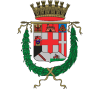A monument of eighteenth-century hydraulic engineering, the Porte Contarine water basin was constructed when a member of the Contarini family was podestà. It may take its name from him or it may be named after the district in which it is located, which was formerly called Contrada Contarinorum. The Water Basin was an important transport junction because it linked together two different waterways: the Naviglio Interno, which flowed from the south through the centre of the city, and the Piovego, which ran from the city towards the Venetian lagoon. The difference in water level within the basin would actually provide the hydro-electrical energy used to power Padua’s first electric street lamps in 1900.
The Oratory of the Blessed Virgin, which overlooks the Porte Contarine Water Basin, is dedicated to Our Lady of the Boatmen [barcari], who paid for its construction in 1723. On a plaque on the west wall of the Oratory are engraved the price rates for the passage through here of various types of vessel. The text, however, is not fully legible because it was scratched over in the early nineteenth century – perhaps to erase an image of the Lion of St. Mark. In the lower part of the plaque there is a list of the various sorts of vessels used for the transport of timber or for passenger traffic. The green-planted flood beds one can admire here are laid out at the foot of the Venetian city walls. These were created after the city had been besieged and then captured by the forces of Emperor Maximilian of Austria in 1509, during the War of the League of Cambrai.
Padua was almost immediately recaptured by Venice, and the Senate then ordered the updating of its defences, the result being a perfect example of contemporary military architecture
- DISCOVER
- LIVE
FOCUS
- GET INSPIRED
FOCUS
- INFO
- BOOK NOW












